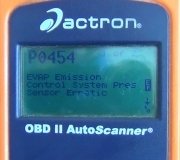This article will be helpful:
https://www.2carpros.com/articles/evap-system-code-repair
It is most helpful to know the exact fault code number. You can see the definitions here:
https://www.2carpros.com/trouble_codes/obd2/p0500
or I can interpret them for you. In this case the code will specify whether it is a "small leak" or a "gross leak". That can help point you in the right direction. Since you can smell the gas fumes, it's a pretty good bet it's a gross leak, and not likely to be the gas cap. Those fumes will blow away while you're driving.
Given the age of your car, a leaking fuel supply line is a good suspect, especially if you live in one of the states where they throw a pound of salt on an ounce of snow. There can also be dry-rotted rubber fuel hoses where the steel lines connect to the gas tank and where they transition from the body to the engine. Look for wet spots on the ground and under the car. Check the gas fill tube for loose or rusted hose clamps.
If the smell is worse under the hood, check for wetness around the injectors. That is usually caused by leaking o-rings on them. Solenoid-controlled emissions valves can develop leaks too but those are usually too small to smell.
Small leaks can be just about impossible to find without the aid of a smoke machine. Those inject a white, non-toxic smoke under 2 psi, then you watch for where that smoke is sneaking out. This works best for vacuum leaks and for leaks in the fuel vapor recovery system, (which is the system that sets these fault codes). It doesn't work well for the fuel supply system because you're trying to inject a low-pressure smoke into a high-pressure liquid system.
Look around the charcoal canister too. That is where the fuel fumes are collected and stored until they're drawn out through the "purge" valve to be burned in the engine. That is another good place to find dry-rotted rubber hoses.
There's a couple of tricks you can do to get some clues. First, if you have to crank the engine considerably longer than normal before it starts, after sitting a few hours, it's a good bet fuel pressure is bleeding down due to that leak. You should be able to find that type of leak through smell, right after stopping the engine. If you smell the gas fumes a few hours after stopping the engine, it's a better bet they're coming from the vapor recovery system
If you need to use a smoke machine, ask at a few local auto parts store. Many of them borrow or rent tools, and you might find one there.
SPONSORED LINKS
Thursday, April 9th, 2020 AT 4:00 PM




